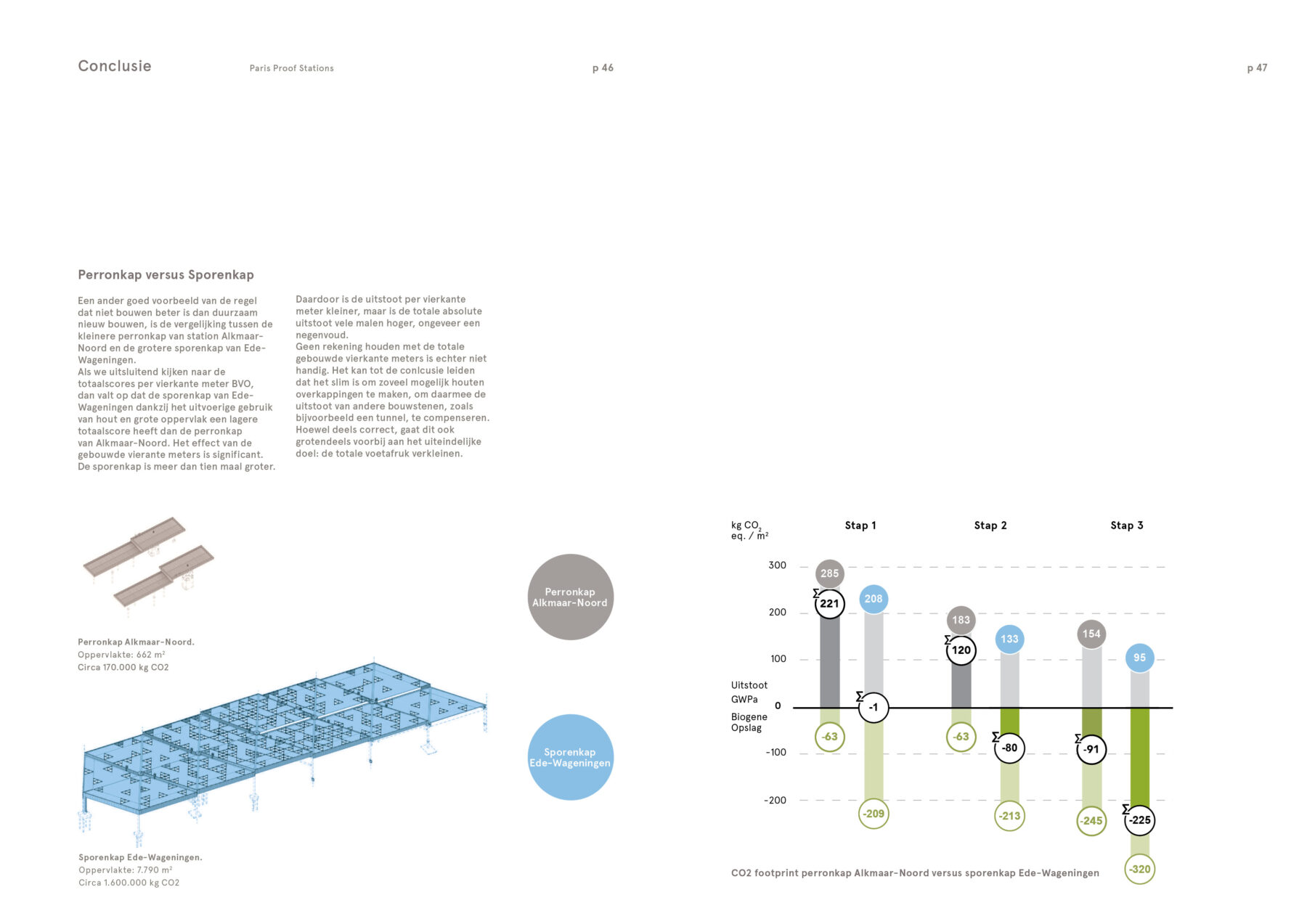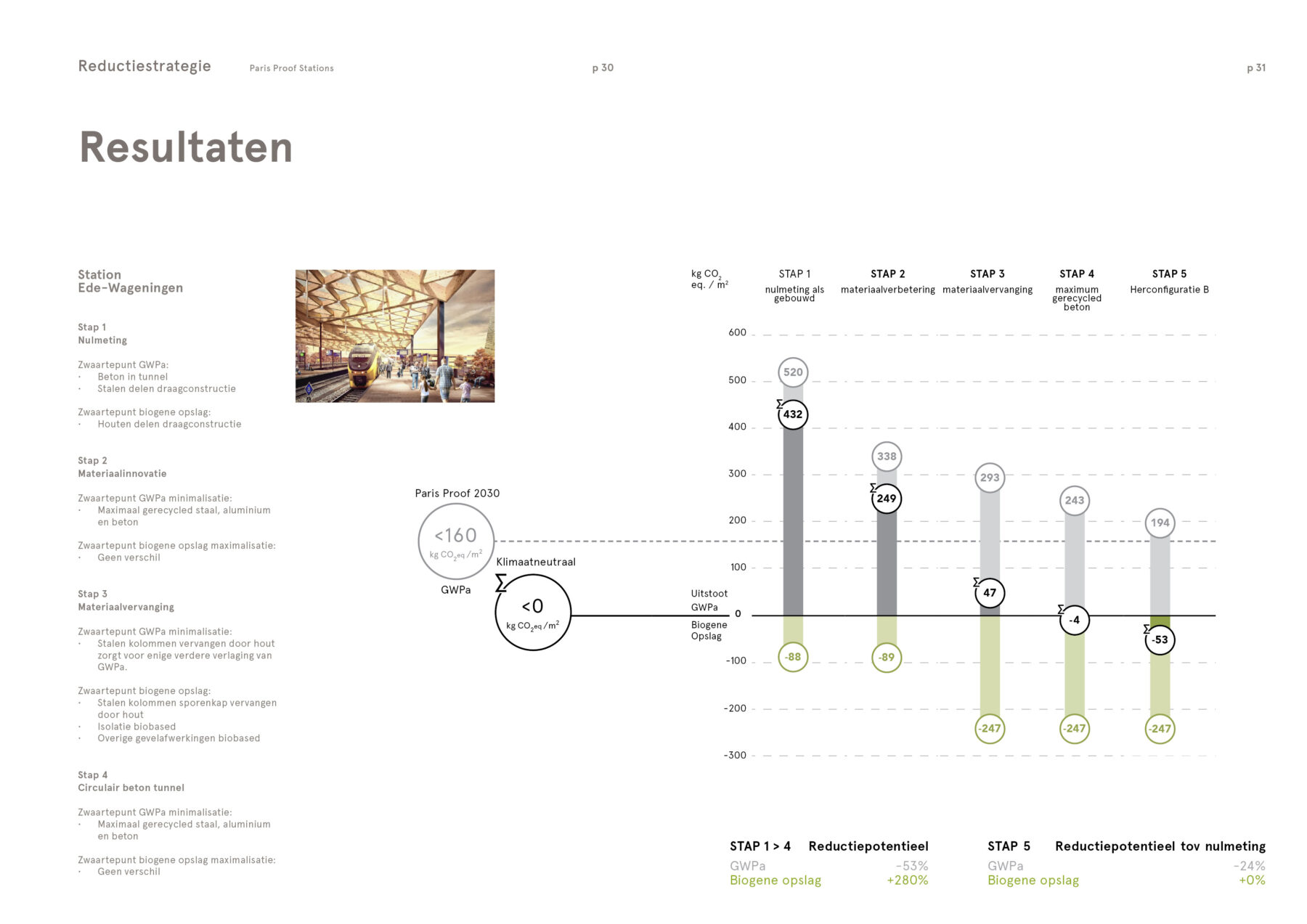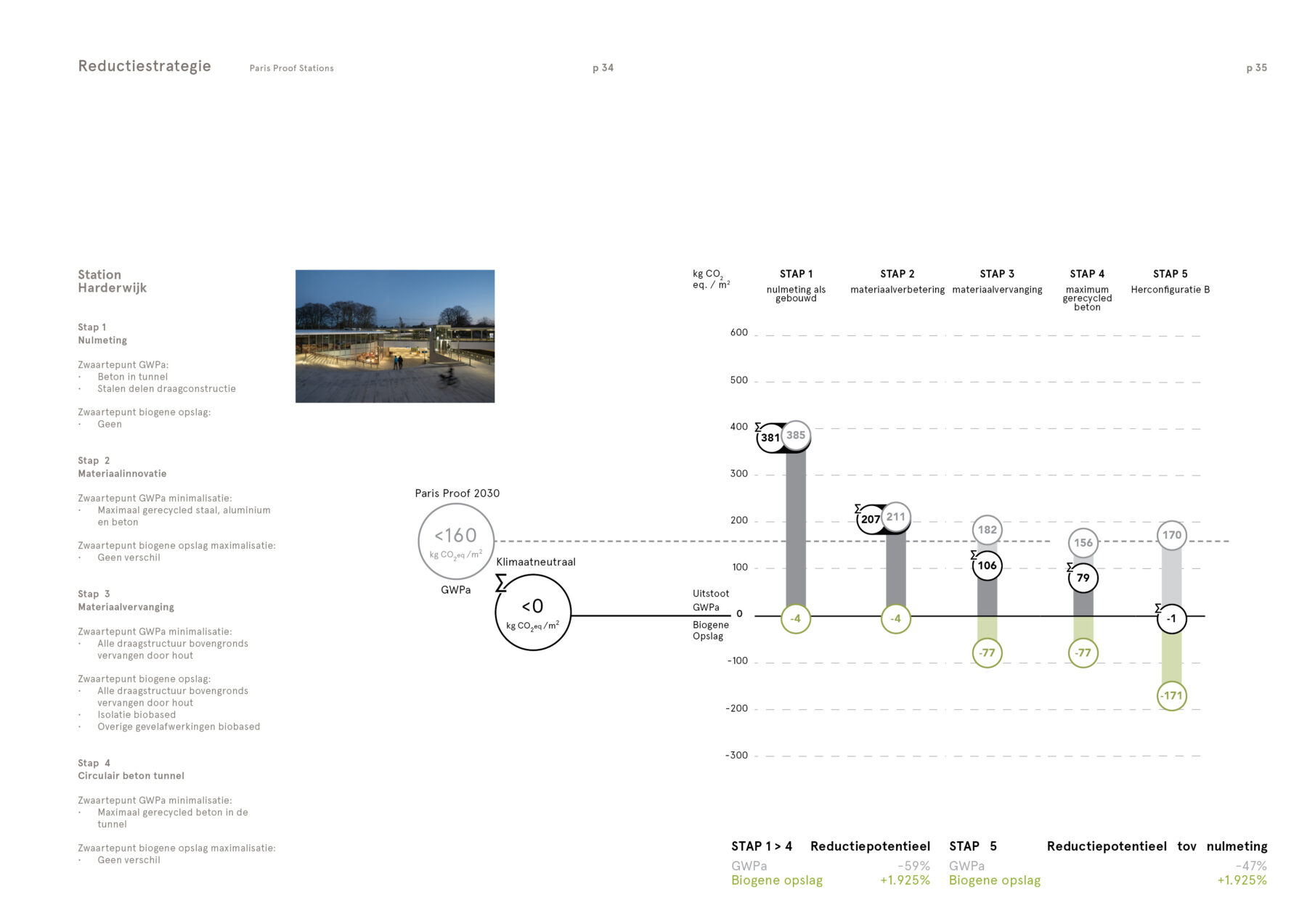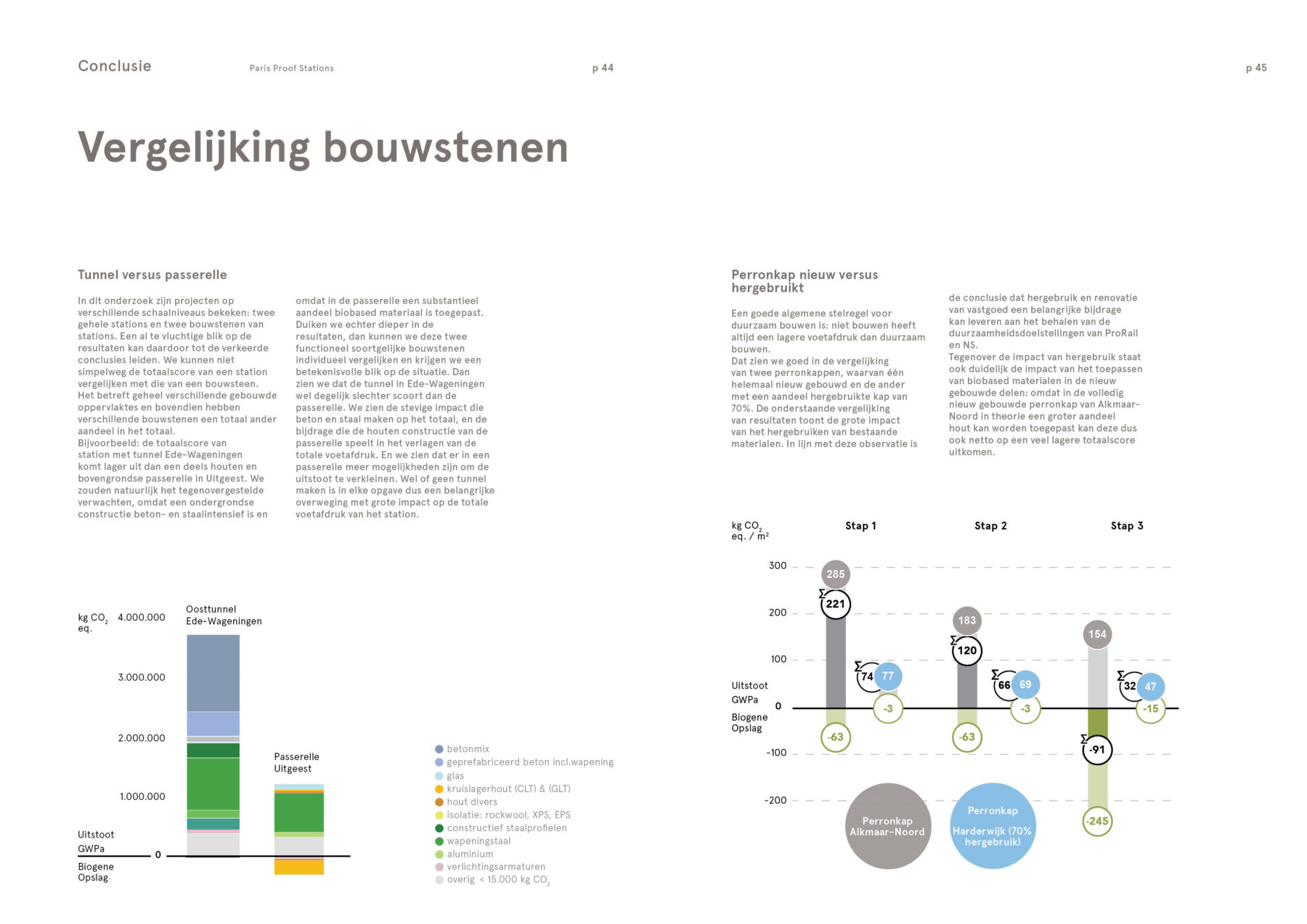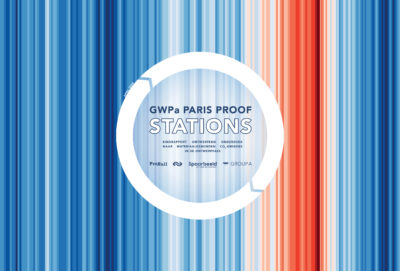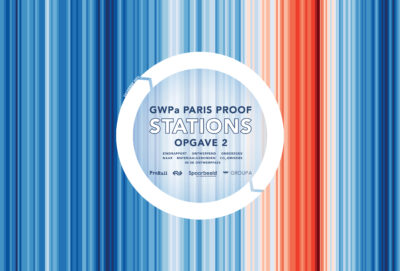Commissioned by ProRail, NS Stations and Bureau Spoorbouwmeester, GROUP A’s CARBONLAB is investigating embodied carbon emissions in station buildings and platforms. The aim of the study is to gain insight into the CO2 footprint and required CO2 budgets for stations. An approach that should make it possible to eventually keep the emissions from stations within the limits of the Paris Agreement: GWPa Paris Proof Stations research by design on embodied carbon emissions in the design phase. Read more about the study and download the final report. Following up on this research Task 2: Public transport nodes has been published.
Urgency
The Climate Act sets clear and binding targets for reducing CO2 emissions: 55% less CO2 emissions in 2030 compared to 1990 and 95% less CO2 emissions in 2050. In addition, the ambition of the Dutch Ministry of Infrastructure and Environment is to design and build climate-neutral infrastructure as early as 2030. The Dutch rail sector has translated the goals into its own ambitions, some of which are even slightly higher, and is working with the Dutch government to achieve them.
Many plans now on the drawing board will not be implemented until after 2030. This means that if we want to achieve these goals we must take concrete action in our project planning tomorrow.
NS and ProRail have insights into and manage to reduce operational emissions. But at the start of the study, there was no concrete insight into the state of affairs regarding the embodied carbon emissions associated with the stations’ development ambitions. Nor was there any clear direction to be taken to reduce these CO2 emissions. Additional research and instruments were needed to achieve the goals related to the reduction of CO2 emissions.
Strategy
This design research is the first step in developing an embodied carbon budget-oriented approach. We define Global Warming Potential as emissions associated with modules A1-A5 (GWPa) for this study.
In the rail sector, there is a strong need for knowledge and strategy on CO2 budgets. A CO2 budget for stations with cap values can work as a catalyst and connecting link between the development of public transport nodes within set sustainability targets. Such a budget is not yet available for stations.
The advantages of a CO2 budget are:
- CO2 budgets make sustainability quantifiable and potentially controllable.
- CO2 budgets make trade-offs possible: tailor-made interventions can be used for each project to spend the budget as smartly as possible.
- CO2 budget strategy is needed for the upcoming distribution of scarce CO2 budgets.
Approach
For four already designed and partly built stations (Ede-Wageningen, Harderwijk, Uitgeest and Alkmaar-Noord) a so-called baseline measurement was made and the embodied carbon emissions of the entire station or of a number of building blocks were calculated. Comprehensive and up to date CO2 data was not yet available for any station in the Netherlands; the study provided valuable insight into the size of the CO2 footprint at a detailed level and where the greatest impact is.
The materials of these projects, captured in digital building models, are linked by certified software to recent, independently verified climate data in which embodied emissions and biogenic storage (the storage of CO2 in biobased materials) are registered. In this way, they provide a reliable and accurate picture. The biogenic storage of the projects was also mapped, as this contributes to CO2 neutrality.
A multi-step reduction strategy was then examined. This involved examining what reduction in embodied carbon is achievable by redesigning stations, either with maximally circular materials (e.g., a steel beam is not constructed with new steel but with recycled steel) or with material innovations (e.g., the steel beam is executed in a wooden beam, fossil insulation boards are executed in biobased insulation boards) or adjustments in the design or configuration of the design: e.g., replacing a pedestrian tunnel with a wooden footbridge.
Conclusions
For the stations studied, the study generated the following conclusions:
- GWPa reduction is a gamechanger, it fundamentally affects station design.
- With maximum circularity of the stations, a GWPa reduction of 35% to 45% can be achieved!
- By constructing everything above ground with bio-based materials, an additional reduction of 9% to 18% can be achieved.
- By constructing everything that must inevitably be made of concrete (tunnels, foundations) in maximally circular concrete, an additional reduction of 14% to 18% can be achieved.
- By configuring the stations differently (passerelle instead of tunnel) a 21% to 24% reduction can be achieved
- Stations of this scale can be made GWPa Paris Proof 2030, but only by taking all the above measures in a combination appropriate to that station.
Read more about Paris Proof Stations or read the full report.
Facts
Client
ProRail, NS Stations and Bureau Spoorbouwmeester
Assignment
Research by design
Location
Netherlands
Area
4 stations
Start design
Q3 2023
Completed
Q2 2024

